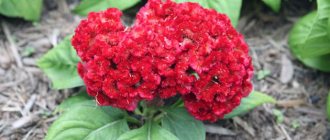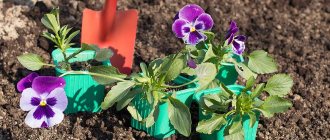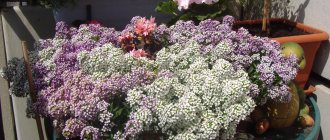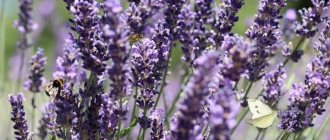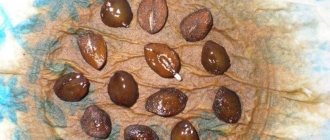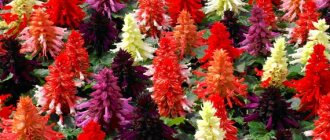Delphinium, also called larkspur or spur, is a very beautiful herbaceous flowering plant of the ranunculaceae family. With good care, perennial delphinium bushes reach two meters in height, have many flower stalks, and the inflorescences of some varieties are up to a meter long.
Let's add to this that modern varieties have denser inflorescences, that is, the flowers are located closer to each other. The flowers themselves became double.
The color scheme of delphinium can satisfy the most sophisticated taste. These are all shades of blue, blue, violet, lilac, and let’s not forget about white.
Thanks to all these advantages, delphinium has firmly taken its place in gardeners’ flower beds.
Delphinium propagates by dividing the bush, cuttings and seeds. But most often the gardener is interested in propagation by seeds, since he wants to see other varieties in his garden - the achievements of the latest selection, and not just what is already growing. Therefore, let's talk about how to properly grow strong, healthy seedlings.
Seed selection
Delphinium seeds lose viability very quickly. Their shelf life is only 11 months. Therefore, when purchasing seeds, be sure to look at the collection date. Do not buy seeds that were collected the year before. Well, last year we harvested it in the summer, this year we need to sow it.
Delphinium seeds
As for the varieties... there is such a variety that you want to try everything. There is one recommendation. If you have never grown delphinium from seeds, then take cheaper varieties, there are more seeds in one bag, there is room for error. These delphiniums are also beautiful when they bloom, and you won't lose anything.
And if you already have experience, then feel free to take on the likes of the New Zealand Giants. They are quite expensive, the number of seeds in one bag is 3-4. But if you manage to grow them, then you can proudly show off your delphiniums to the envy of all your neighbors.
Delphinium New Zealand giant
They often give recommendations to collect, store and then sow your own seeds from your delphinium. If this is not done for the sake of sales, then there is no point in doing it, and here's why.
Delphinium reproduces well by self-sowing. You just need to leave a few flower stalks on the bush, let them ripen, and you will let them ripen anyway if you want to collect the seeds and let them fall out on the ground. All. No more effort is required from you! Well, perhaps, to control yourself and not weed everything that sprouts under the delphinium bush in the spring.
And in the spring, you dig up ready-made powerful seedlings and plant them in the right place. And this without any nerves and labor costs
If you really don’t like it when the soil is covered with weeds, then select some piece of land for the delphinium, where you can safely shake the seeds from the flower stalks. You don't even need to cover it with soil. After all, when the seeds fall on their own, no one buries them on purpose. Weed by hand so as not to remove delphinium seedlings.
This method would also be suitable for purchased seeds. But we all know how many of these seeds are in a purchased bag! Now imagine that in the very place where you sowed 10 precious pieces of seeds of some very expensive variety, some impudent mouse makes a move.
This means that we grow seedlings from purchased seeds according to all the rules. And the first and very important rule is proper seed storage. This is the key to all future work.
Delphinium seeds must be stored in the cold!
We bought a bag of delphinium seeds and, without delay, immediately put them in the refrigerator. And let the seeds lie somewhere in the door until planting. Delphinium seeds that have not undergone cold treatment will not germinate! Remember this! It is important!
What to do if you bought a long-awaited variety only recently, but are about to sow it? Then put the bag of seeds in the freezer for at least a week. Nothing will happen to the seeds, and their germination will increase.
Don't put off buying delphinium seeds until spring. Buy in the fall, immediately after fresh picking, and immediately put them in the refrigerator for proper storage.
Popular types and varieties of delphinium
Delphinium was noticed by breeders back in the second half of the 19th century and to this day enjoys constant popularity, expressed by new varieties. Among the most popular are:
- Princess Caroline - with flowers of delicate pink tones, there are types of rich red colors. The bush is quite powerful, grows up to 185 cm. It is characterized by long flowering: from early June to early September. Prefers shady places and does not tolerate the scorching sun.
- Bellamosum - with dark blue flowers and up to 125 cm in height. It blooms from July to September and loves sunny places. It tolerates frost well and can go without moisture for a long time.
- Snow lace is snow-white in color with a brown center and is highly fragrant. The bushes grow up to 150 cm, are very thermophilic and prefer sunny areas. Flowering begins in July and continues until September.
- Pacific mixture - with flowers in blue, white, purple and pink tones. It grows up to 185 cm, the flowering period is divided into June-July and August-September. It prefers to bloom in slightly shaded places and tolerates hot weather well.
- Butterfly is a dwarf variety with large flowers in dark blue tones. It prefers cool weather and tolerates frost well, wintering under snow.
- Pink butterfly - with large pyramid-shaped flowers in delicate pink tones. The external design resembles a flying butterfly; they can grow up to 100 cm.
- Lavender obelisk - inflorescences with a vanilla aroma, mainly lavender shades and a black center, grow up to 165 cm. Frost-resistant variety.
- Spring snow - with white flowers, a smoky admixture of light lilac tones and a brown center. Grows up to 185 cm, not afraid of light frost.
- Summer morning - large flowers of pink and purple tones with a white center. They grow up to 165 cm, are very thermophilic and prefer sunny areas. Recognized by gardeners as the most unpretentious in care.
- Morpheus - double large flowers of rich purple tones with a golden center. Capable of growing up to 165 cm, easily tolerates cold.
D. Princess Caroline
Timing for planting delphinium seedlings
So, when is it better to sow delphinium for seedlings?
It all depends on whether you want to see the new variety bloom this year. If yes, then you need to sow in January. But we must remember that if your plants do not receive enough light, they will stretch out, become weak and unviable. And such plants are easily affected by various diseases. Therefore, illumination with phytolamps is necessary.
The usual sowing dates are the end of February and March. It all depends on when spring comes in your region and you can plant seedlings in open ground. The later spring comes, the later it is necessary to sow delphinium seeds for seedlings. This is necessary in order not to overexpose the seedlings in unfavorable apartment conditions.
In the Moscow region we approximately sow in mid-March, the Southern regions - the end of February, and the Northern regions - the end of March
Delphiniums as part of landscape design
Well, now you know how to plant, grow and when to replant delphinium. What role can this plant play in yard design? Delphiniums are always planted in groups on a site. This makes the plant look much more impressive. At the same time, it is worth growing varieties with inflorescences of different colors in one flowerbed. Very often, delphiniums are used as background plants in mixborders. At the same time, it’s a good idea to combine them with phlox, roses, lilies, and dahlias. Sometimes delphiniums are planted near the front porch of a house or along its facade.
Preparing seeds before planting
We have already talked about cold storage of seeds. The seeds themselves do not need to be treated in any way before planting.
But if you have vague doubts, you can disinfect the seeds with phytosporin. To do this, place the seeds in a gauze bag, the bag in a phytosporin solution (follow the instructions), then rinse with water and keep it in the epin solution (see instructions). After this, lightly dry the seeds and sow.
Disinfect seeds with phytosporin
Diseases and pests (treatment)
Delphiniums, like other representatives of garden crops, can be subject to unpleasant diseases or infestations of insect pests. Common flower ailments.
Powdery mildew is a fungal disease that occurs in cool, humid weather. The leaves and stems are covered with a white coating, which gradually turns brown. The infected plant dies.
The disease in its later stages cannot be treated, but it can be prevented by simple methods: sparse planting and regular removal of excess shoots to ensure ventilation. At the first signs, the plant is sprayed twice with “Fundazol” or “Topaz”.
Ramularia leaf blight is a fungal disease that manifests itself in the form of dark spots over the entire surface of the leaves, which leads to their drying out and falling off. At the first manifestations of the disease, the flower is sprayed with special antifungal chemicals, and the affected areas are completely removed.
Ring spot is a virus that manifests itself as numerous yellow ring-shaped spots. The affected areas are not treated, they should be completely removed, and the plant should be sprayed with Karbofos, Aktara, Intavir or Actelik.
Black bacterial spotting - the disease manifests itself in black spots of various sizes and shapes. The spotting first affects the lower leaves, then gradually rises higher, including along the stem, making the flower dry and brittle, leading to final death. At the first signs, the spurs are sprayed twice with tetracycline (dilute 1 tablet per 1 liter of water). Affected areas are immediately removed.
In addition to diseases, flowers can also be attacked by harmful insects. The most common among them are:
- Delphinium fly, which clogs the buds with laid eggs, and the hatched larvae eat the stamens with pistils, which leads to the rapid shedding of the flower and eliminates the appearance of seed material. Timely spraying with insecticidal preparations will help in the fight against flies.
- Caterpillars and slugs that love to eat fresh stems and leaves, especially young seedlings. You can fight them with chlorine. Small containers with the drug are placed between plantings and create a repellent odor. In this case, pests must be collected manually to prevent their further spread.
Selecting a container for planting
There is no need to choose containers that are too large for sowing. The fact is that the seedlings have a small root volume. Roots cannot fill a large volume of soil, and soil without roots begins to turn sour, which promotes the development of all sorts of pathogenic bacteria and fungi.
Disposable salad containers work very well. They are not deep, which is good for seedlings. It is very important that containers are washed thoroughly if they are not new. There should be no leftover food. No traces of fat.
Disposable containers for seedlings
In a thoroughly washed container, make holes in the bottom to drain the water. The holes must be large enough. Small holes can become clogged with soil and water will stagnate in the container.
Soil preparation
Delphinium seedlings love loose, air- and water-permeable soil. Many gardeners advise using ready-made soil for succulents or cacti.
But if you want to prepare the soil for delphinium yourself, then take
- coarse sand – 0.5 parts;
- turf soil - 1 part;
- peat – 1 part;
- humus - 1 part
Add perlite (1 cup per 10 liters of prepared mixture) and mix everything thoroughly.
Pour the prepared soil mixture into your prepared container for sowing. Do not fill the soil all the way to the top. Leave an air space of 1-1.5 cm up to the lid.
Now the soil needs to be disinfected. One way is steaming. Simply microwave your disposable container of soil for 8-10 minutes. And all living things in the soil will be killed. But this is not always good.
If you bought biosoil that contains beneficial bacteria, then with the help of steaming you will kill everything useful. Therefore, it is better to treat the soil with a solution of phytosporin.
Water the soil thoroughly. It is better to do this in advance, about a day before sowing. So that all excess moisture is glassed off.
Sowing
Let's get to the fun part. We sow delphinium for seedlings.
Spread the seeds over the surface of the prepared soil. If you are sowing varieties that have literally several seeds, then insert a toothpick next to each seed. This will make it easier for you to monitor whether the seed has sprouted or not.
There is no need to sprinkle the seeds with soil. Close the lid of the container tightly. Delphinium seeds germinate in the dark.
Therefore, place the container with the crops in a paper bag and secure it with an elastic band. Place the finished bag in the refrigerator for two weeks to stratify. Some gardeners do not place the container in any bag because it is already dark in the refrigerator, and it will be much easier to take out the container, open it and monitor the seedlings. There is no need to additionally ventilate the contents of the container.
It is enough that you lift the lid once a day for inspection. This will be the ventilation. If necessary, moisten the soil. From the tenth day, shoots may begin to appear. Therefore, you will need to look into the container more often.
When the first shoots appear, immediately transfer the seedlings to the light. Don't forget to remove the cover.
Botanical description
Three unofficial and one scientific name for delphinium do not answer the most important questions. How to plant, how to monitor its successful development, what to do to ensure that the flower is lush and healthy? If you know all the botanical features of development, then you can only guess the basics of care.
Flower culture has more than 400 species. Ranunculaceae family. Varieties are divided into annual and perennial. Availability of a large number of colors. Interesting, unusual inflorescence shape:
- unique;
- individual;
- tender and graceful.
It is distinguished by high endurance and can survive mild frosts. Not afraid of shading. Despite all its positive qualities, delphinium is not a frequent resident in gardens and home areas. Reason: flower varieties are poisonous. There are also ornamental and wild plant species.
Caring for seedlings after emergence
Delphinium seedlings are quite capricious. To grow strong seedlings, it is necessary to observe the temperature regime. The temperature should be 18-20 degrees Celsius. At temperatures below 18 degrees, plants begin to wither and there is a risk of blackleg disease.
Plants do not feel well even when the temperature rises above 20 degrees. Therefore, it is better to buy a thermometer to accurately regulate the temperature.
Lack of light also has a bad effect on delphinium seedlings. Elongated seedlings are more susceptible to various diseases. In case of lack of lighting, phytolamps will help. The light regime should be 12-14 hours.
Another important condition is proper watering. It is better to water through a tray. We poured water into the pan, the soil took up as much as it needed, after 20 minutes all the excess water was drained.
Try not to overdry the soil. Water as soon as the top layer of soil has dried. Remember that the container with seedlings is not deep and the soil in it dries out quickly.
Picking delphinium seedlings
To pick seedlings (transplant seedlings into separate pots), you need to prepare suitable containers and soil.
At this stage, disposable cups or containers with a capacity of 0.2 ml are suitable. Do not try to transplant into large pots right away. The reason is still the same; without a sufficient number of roots, the soil will become acidic. When the roots completely fill the volume of the container, then it will be possible to transfer them into a larger pot.
Be sure to check for good drainage holes so that water does not stagnate in the pots. And please note that all containers must be thoroughly washed and disinfected, especially if seedlings have been grown in them before.
The soil for picking is the same as for sowing. This is either ready-made soil for succulents and cacti, or prepared independently according to the recipe described above in the section on sowing seeds
Fill the containers with prepared soil. Do not pour the soil level with the hill. Let there be free space up to the edge of the pot. This will make watering more convenient. Thoroughly water the soil with phytosporin solution to disinfect. It’s better to do this in advance, about a day in advance, so that all the excess moisture drains away.
Seedlings are usually picked when 1-2 true leaves appear. But usually seedlings are rarely leveled. Some seedlings already have 2-3 true leaves, while others have just begun to grow.
If there are few seedlings, then feel free to replant the entire plant. Those that do not yet have true leaves will also take root and grow if the rules of care are followed. But we must always remember that those plants that, under equal conditions, sprouted later, have less growth energy and will not show better results. Therefore, if there is a sufficient number of seedlings, give preference to stronger seedlings.
Before picking, thoroughly water the soil in the container with the seedlings. The better you shed, the easier the plants will be separated from each other and the roots will be less damaged.
Make holes in the soil of individual pots of such a size that a lump of earth with the roots of the transplanted plant can easily fit there.
Carefully dig up the seedlings with a plastic fork and transfer them to the prepared holes. Sprinkle with soil. Try to deepen the seedlings to the point of growth. It should be above ground level. Otherwise, the plants may stop growing and die.
Water the seedlings carefully to compact the soil at the roots. There is no need to trample the soil around the plant with your fingers. By these actions you can damage the roots, and you can also disrupt the air and water permeability of the soil near the roots.
The next watering will need to be done in about a week. This is necessary so that the roots, in search of moisture, begin to grow further in the earthen lump. But if you see that the soil has become too dry, then water earlier.
In the first days after picking, try to protect the seedlings from direct sunlight. It is better to remove the plants from a sunny window and illuminate them with phytolamps. This way the seedlings will take root faster.
Further care for seedlings is the same as for seedlings. Maintain a temperature of 18-20 degrees. Daylight hours should be 12-14 hours. And timely watering. Do not overwater the plants and do not let them suffer from lack of moisture.
Typically, delphinium seedlings do not need additional feeding if you have prepared the soil well. But, if you notice that the leaves of your seedlings have begun to turn yellow around the edges or some other signs of mineral starvation have appeared, then feed them once with flower food according to the instructions.
Further care
Carrying out proper care means monitoring development. This includes timely watering and weed removal. There is another trick that allows the delphinium to grow quickly: at a height of 10-15 cm, shoots are cut off.
At the same time, the strong ones (2-3 pieces) are left. Immediately apply complex fertilizer. This way, stimulation of active development will be more effective.
Since the delphinium quickly pulls out its stems, it is recommended to drive stakes near the bushes. The garter does not allow the young stem to develop crookedly. Support can only be removed in the fall.
Another important point in care: pruning. Carry out during the initial stage of flowering.
Transplanting delphinium seedlings into open ground
Timing of planting in open ground
When can you finally plant seedlings in open ground? If you are sure that there will be no more frosts, or you have the opportunity to protect your seedlings from low temperatures, then feel free to plant them. It is desirable that the seedlings already have 6-8 true leaves by this time.
In nature, seedlings of perennial delphinium are not afraid of return frosts and easily tolerate them. But from the very first days they adapted to such conditions, and those who did not adapt did not survive.
Our seedlings were grown at home, protected from temperature changes, from night frosts, and from gusty winds. Yes, she is pampered. Freezing will kill her
Yes, even if you just take pots of seedlings and put them outside in the warm sun and leave them like that all day, this will also not bring anything good to the seedlings and will cause severe stress to our plants. Therefore, it is necessary to prepare plants for planting in open ground gradually. First, we get used to the flow of fresh air through an open window.
Then we briefly expose it to the open air, protecting it from direct sunlight. We gradually increase the time spent outdoors.
Only when our plants can be outdoors without harm to their health, then we begin planting.
Choosing a delphinium planting site
Delphinium most often grows tall, so they choose a place in the background so that it does not block other flowers.
The place should be sunny. It’s good if a light shadow falls on this place in the midday heat
You also need to take into account that delphinium flower stalks are very fragile and can easily break from gusts of wind. Therefore, do not plant in heavily blown places. It is good if the delphinium is protected by a wall or fence on the leeward side.
And the last nuance that must be taken into account when choosing a place. After flowering, the delphinium becomes, to put it mildly, sloppy. Drying flower stalks with yellowing leaves... But you can’t cut them off too early, because nutrients must go from them to the roots. Therefore, plant delphiniums behind other perennials that can hide the unpleasant picture from the eyes.
Preparing the soil for planting
Delphinium is a friend with a very good appetite. In order for it to feel good and delight you with lush flower stalks, the soil must be thoroughly fertilized.
Here is an example of how a gardener prepares the soil for planting delphinium.
He digs up a small plot of earth about a meter by meter to a depth of one and a half spade bayonets. He pours a wheelbarrow of humus there, then scatters a glass of Kemira fertilizer, a glass of bone meal and half a bucket of ash over the entire plot. All this mixes with the earth. That's it, the landing site is ready.
Planting delphinium seedlings in open ground
The seedlings are hardened off, the soil is prepared and fertilized. There is very little left. Plant seedlings in open ground.
Dig planting holes at a distance of 30 cm from each other. Transfer your plants from their pots there. Sprinkle with soil and water. To prevent the soil around the seedlings from drying out too much, mulch it with humus.
Further care consists of timely weeding and watering. The soil is already well-filled with nutrients, so in the first year of planting there is no need to feed the plants in any way.
X
Delphinium flowers: description and photo
Delphinium, also known as Spur, belongs to the genus of herbaceous perennials of the Ranunculaceae family. The northern hemispheres of the planet and the mountain-tropical terrains of Africa number up to 450 varieties of the plant, about 170 species originate in the south-eastern countries of Asia, and approximately 100 varieties of delphinium are found in Russia and its neighboring countries.
According to one version, the garden flower received its name due to the external resemblance of the buds gaining color to the shape of dolphins. Another version says that the name is derived from the city of Delphi in Greece, the surroundings of which were full of these beautiful flowers.
The external appearance of the leaves of the plant is palm-shaped and divided, with frequent dissections into jagged or pointed parts. The cut leaves come in shapes of three, five and seven divisions, rounded outlines and large segments, some of which are narrow and thin, giving the leaves a lace-like robe. Plants reach a height of 2 m, and dwarf varieties grow up to 45-50 cm. Spur has a powerful root system with a well-branched rhizome and a large number of adventitious roots.
Over time, the middle part of the rhizome tends to die off, and the lateral shoots grow in width, forming multiple new plants.
The shape of the flower is formed by five colored petal-shaped sepals, the upper of which contains a hollow funnel-shaped appendage called a “spur”, with two nectaries located inside it. Spurs come in small sizes, depending on the type, their parameters vary from 5 to 10 mm for dwarf varieties, and from 2 to 4 cm for large varieties.
Some varieties contain eyes or staminodes in the center of the flower, which are small petals designed to serve as a kind of runway for pollinating insects. Most plants are blue or purple in color, but there are also species of other colors.
By the way, the plant's pollinators are mainly bumblebees.
